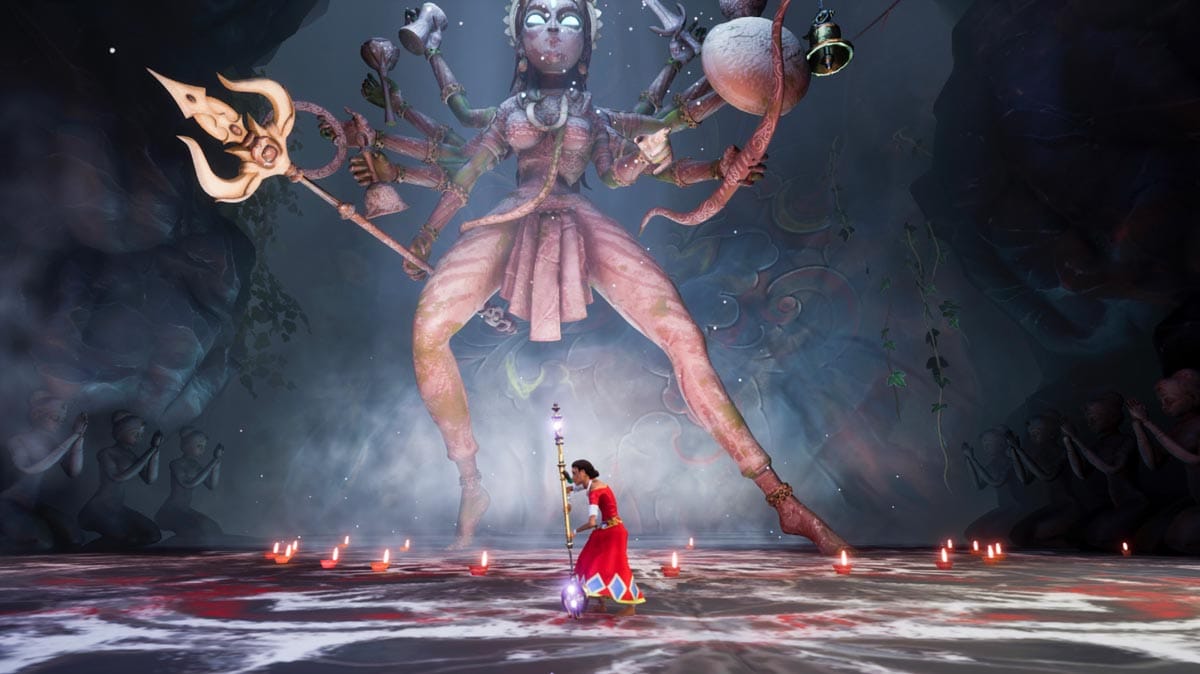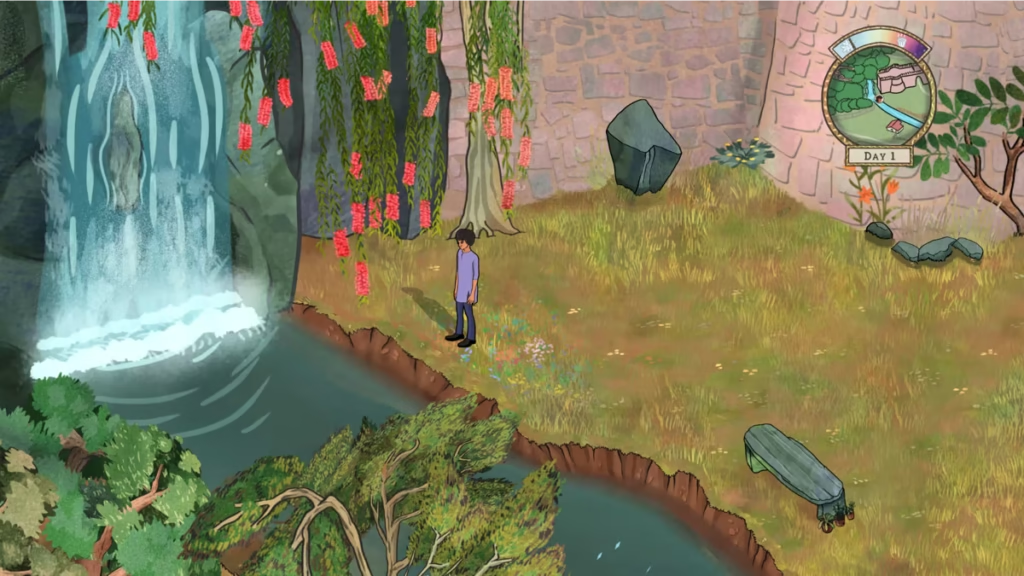Welcome to the third edition of Drop C++, a series about the people who put the music into your favourite (and not-so-favoured) games. Over the course of discussions with a variety of musicians, composers and sound designers, this set of articles will seek to shed some light on how the music comes together, the people who make it, what inspires them and more. And with that out of the way, here comes Volume 3 of the series.

A little over a week ago, Greek progressive rock duo Loom completed the final date on a mini tour. Who are Loom? A band whose raison d’être is to make music that is written as a score to original oil paintings. The group comprises drummer Stefanos Meichan and musician-composer-sound designer Linos Tzelos, the subject of this edition of Drop C++. “We just started making some music. So, we only have an Instagram profile; the project is very small at the moment. But this is my main thing to accomplish right now,” he says and explains, “We have a sequence of paintings telling a story within pictures. And the music and lyrics are an accompaniment to that — it’s like emotional art almost.”
The music, Linos elaborates, is similar to that of American progressive metal heavyweights Tool (and he’s not wrong, go check it out for yourselves) “The tension-and-release kind of compositions. Having the visuals in the background with all the paintings. It’s all very archetypal,” he adds. But it’s not Loom we’re here to discuss, not this time anyway. Instead, it’s his work composing music and designing the soundscapes for The Game Awards 2020 nominee Raji: An Ancient Epic.
The Raji journey
Four years ago, the Nodding Heads Games debut dropped to worldwide acclaim and showcased a new standard of games coming out of India. “My first impression of the project was that it was massive and demanding; there were so many things to do, so it was a bit overwhelming,” recalls Linos, “But as soon as I got into it, I just loved it. Being with the team, creating a world from scratch and going through all these Rajasthani, traditional music and concepts, and aesthetics in general — it was magical for me.”
The premise, for the uninitiated, is as follows: Raji: An Ancient Epic is an action-adventure game based in Rajasthan, that centres around the titular protagonist, an orphaned circus performer, whose brother is kidnapped by a demon army. What follows is her journey into various strands of Hindu mythology to mount a rescue. Along the way, she encounters gods, goddesses and all sorts of creatures, and picks up a bunch of powers and abilities that help with her mission.
I know what you’re thinking right now: Just how did a prog rocker from Greece end up creating music for this inherently Indian game? It’s a good question and fortunately, Linos is on hand to answer. “The first time I was in India was in 2014. I was on a visit to explore the music and culture of the country. It was there that I met Avichal Singh (co-founder and game designer, Nodding Heads Games) through a mutual acquaintance,” he says, “We began talking and he indicated an appreciation for some of the music I was working on. And then, as soon as I left India, he contacted me that he had a plan for a game with some friends of his. Over the years, we discussed more and more of the plans until he asked me to become the sound designer and composer.” Linos made his second trip to India in 2018. This time, it was to begin work on Raji: An Ancient Epic.
Considering the setting of the game, among the key reasons Linos was identified for this role were his time spent soaking up all things Rajasthan and his skill on the Ravanhatta (see above). “I’d spent a month in Rajasthan just learning that instrument and was really into the culture,” Linos explains, “So, Avichal thought, ‘This is the right guy for us — he’s from Europe, he understands Western music, but still has a knowledge of the culture that we want to represent through Raji: An Ancient Epic’.”
As keen readers of this particular series will recall, it all starts with the brief. For some games, it’s a bit of gameplay that music composers are shown, for others, it’s a mood they are asked to create. With Raji: An Ancient Epic, it was the narrative that was at the heart of the brief. “A mythological story. The brief I was given was the storyline about a girl who goes through a major struggle to save her little brother,” recalls Linos, “And this happens across a set of palaces and other locations all over Rajasthan, which was really appealing to me, because it’s a very folklore-rich place with so many traditions.”

Through the twists and turns of the development journey, he insists that the brief didn’t change very much. “But, there were things that became different. And there were several new demands as we went on, but what was asked of me remained the same: To make original pieces of music that actually connect with the aesthetics, folklore and culture of Rajasthan,” Linos says. It’s worth pointing out at this point that while he had worked on films — feature-length and short ones — in Greece and the UK, theatre and a couple of animations, this was his first foray into the world of videogames.
“The hardest part [of the entire experience] was sound design. It was a field that I wasn’t very familiar with — stuff like discussing the implementation of sound and working on a PC for long hours was not familiar territory for me,” admits Linos, “The fight scenes and the combat sounds [were the toughest aspect of all].” The trickiness of all of this stemmed from the various options available to the player in a combat situation.
“Weapon choice, impacts, sounds from Raji, grunts from the demons and all the other effects had to be coordinated in very close proximity because it was all happening at the same time,” Linos continues, “As soon as you hit, you have the impact, and you have the sound of whoever got hit. I remember going back and forth many, many times to just tweak sounds and improve them. And it was made tougher by the fact that it’s a very fast-paced game.”
The origin story
Given the opening segment of this piece, it’s unsurprising that Linos points to Tool as his biggest source of musical inspiration. He also names Nirvana and Pearl Jam among the bands that inspired him during his formative years, but there’s one clear favourite. “I grabbed the guitar at the age of 15 or 16 years just to try and replicate the sound of Tool. And I got very, very close to it. Soon, I remember just playing their albums from top to bottom on my guitar,” he reminisces, adding, “And this made me learn the guitar and play those odd signatures. And that sort of liberating and uplifting orchestration — you know, the tension and release.”
One thing led to another, and Linos was soon jamming with others and getting into jazz and a whole lot of other music. “I love Miles Davis, John Coltrane and Duke Ellington, Pink Floyd, the Beatles and so on rock scene, jazz scene. And, of course, later on, in terms of soundtrack composers, my biggest inspiration is Vangelis… and John Williams, of course,” says the self-taught musician. Noting that he only had a couple of months of guitar lessons at the very most, he mentions that the teacher showed him only the very basics: How to hold the instrument, a few chords and such-like.
“But then, I just ran with it on my own and practising whenever I found a spare minute. The biggest education in my life was like listening to a lot of different types of music and playing with other people,” Linos says, “I joined bands — jazz, fusion and funk bands. And that gave me a lot of practical knowledge. And then, I was able to travel a lot and got my hands on various instruments. From India, I got a sitar, the Ravanhatta and a set of tablas. I also had a small drum kit, a double bass, and pretty much whatever I found on my travels. I just made sure to spend some time on them and understand them.”
Having attained some level of proficiency with all of these instruments, is there one in particular that he favours in terms of the writing process? “Yeah, the instrument is the guitar,” comes the answer, “And how I do it is very similar to my process back when I was just starting out: I just sat and played.” And while Linos’ overall approach remains the same, his process varies from project to project, and from one technological innovation to another. “Earlier, I would just play guitar and use my voice to try and put together a tune. Then the whole production thing happened, like using a PC, dedicated software and a Digital Audio Workstation, and producing music with these tools,” he elaborates, “So I would be spending a lot of time with the software, going through synthesisers, different sounds, beats and all these kinds of things.”
After a few years of doing things this way, Linos — whose own dalliances with videogames extend as far as Crash Bandicoot, Tomb Raider and ‘a bit of FIFA’ — decided to return to the old ways. “For the past five or six years, I haven’t used a computer. I just sit down with a loop station. I put down a few ideas with the guitar and record them on the looper. While I have these loops playing, I usually tend to do different things like wash the dishes or stuff like that,” he says, “And then, just listening to what I wrote helps me come up with melodies or grooves. As soon as I have that idea, I just sit back down and I record it as well. And little-by-little, I just compose the first four or five meters of the song.”
This process continues until Linos has some chords in mind and that’s when it’s time to communicate with another musician, and jam — something he calls a ‘catalyst’ for the work. “I have a drummer with whom I jam and as soon as we begin playing, the picture comes to me. You know, the complete landscape, the transitions and all the little details. So I go and record it,” he says, “And if I like it, if it seems appealing to me, if it’s attractive, then I try to ask myself, ‘What more do you need?’. And this is the same with games and films. It’s the same process, but I tend to go through the scene (or thing that’s happening) several times to try and capture the emotion that I feel as a player or a viewer. And then I try to bring to the fore the message that the creator of the game or film wants to give me for that section or bit.”
As we come to the end of this interaction, I enquire as to what’s next for Linos. “Well, I’m focussed on Loom right now,” he says, “And I haven’t had any videogame work since Raji: An Ancient Epic. I think my next assignment will be the new project with Nodding Heads Games, which is under construction right now.” Exciting times ahead!
A version of this article originally appeared on The Qun


